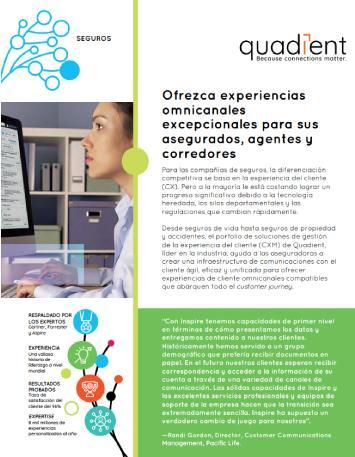Insurtech companies are redefining the focus
It is easy to believe that these new insurers are creating headaches for traditional insurers simply because they are new and flashy and are not held back by legacy technology. In reality, these disruptors approach business challenges from a completely different angle. They place the customer at the center of their business model. Therefore, they can maintain their focus on resources that provide better products, services and distribution to customers. And customers can tell the difference. A recent study shows that customers are willing to pay up to 13% more for services if they offer a quality customer experience.
The insurtech industry, now a decade old and still growing, is using this approach to go beyond customer retention and create brand ambassadors. Some users and customers use their own methods of disclosure, such as social networks, to expose the positive experiences they have with a particular brand or company. In fact, Nielsen reports that 92% of consumers trust referrals from people they know and are four times more likely to buy when recommended by a friend.
Why disruptors are winning
Disruptors are top-tier digital technology organizations that offer their customers one or a limited number of insurance products. Their teams are more agile and quickly address any questions customers may have about their products because, as they offer few products, everyone in the organization is expected to understand them very well and be able to provide informed answers and support quickly.
They are also driven by technology. Insurtech companies are often built from the ground up using technology to create the product; whereas traditional insurers create the product and then find ways to use technology to distribute and service customers. This is where the term insurtech derives from, as most of these disruptors are technology companies selling an insurance product.
They are customer-centric: their business processes, operations, products, services and distribution are based on customer needs and preferences; companies follow their customers as their needs change and are able to adapt quickly.
How traditional insurers win
Expert insurers have created
think tanks
think tanks, innovation labs and other startups within their companies to foster a culture of innovation similar to their disruptors. Instead of focusing on the most profitable product and then trying to manage their massive business to start winning with it, these agile teams examine the gaps in the industry and invest in solutions and products for those gaps. Moreover, they have the autonomy and don’t worry if they lose one euro today if it means gaining two, three or even four in the long run, so to speak. The goal is not a quick win, but to lay the groundwork for long-term success.
When those internal startups are not possible, insurers look for the best technology partners to help accelerate the way they innovate, whether in service, distribution, their products or any combination of the three.
Traditional insurers are also evolving their business, breaking down functional, technical and even knowledge silos to modernize and offer a single customer experience regardless of product or channel, and further reduce costs by centralizing and sharing information.
The power of customer experience
Insurers large and small recognize that the move from being a product-centric, process-driven company to a customer-centric, technology-enabled organization takes time and many planned and deliberate steps. These changes allow insurers to move at the speed of consumer demand. Creating an individualized customer journey experience is paramount, especially in the light of a
study
study showing that by 2020, customer experience will overtake price and product as the key brand differentiator.
Insurance customers do not see and cannot be bothered by business or technology silos. In fact, 55% of
55%
of customers say a frustrating website or mobile experience makes them less likely to interact with a company. Expectations are high; now more than ever customers want choicecommunicate with a live person on the phone, have access to the information they need, and have access to the information they need onlineThe new system allows you to send questions and get answers in real time on your cell phone and on your home or in-car devices to help alert the insurer in the event of a leak or an accident. Insurers are no longer claims processors, but business partners, protectors of life and financial well-being, providing peace of mind to individuals, families and business owners.
If the insurance business is based on trust and relationships, then focusing on clearly, quickly and relevantly communicating information to customers is at the core of the insurance business. And loyalty is fickle without trust built over time. 1 in 3 customers said they would leave a brand they love after a single bad experience.
Great experiences are difficult to replicate, but they are 100% designed. Don’t give your customers a reason to look elsewhere for insurance: the communications and customer experience solutions industry leaders in the Quadient and MailTecK & Customer Comms transform how insurers reach customers today and tomorrow as new channels emerge.
Deliver exceptional omnichannel experiences for your policyholders, agents and brokers
For insurance organizations, competitive differentiation is based on customer experience. Discover how to create an agile, efficient and unified customer communications infrastructure to deliver compliant omnichannel customer experiences that span the entire customer journey.

Content extracted from Quadient.
